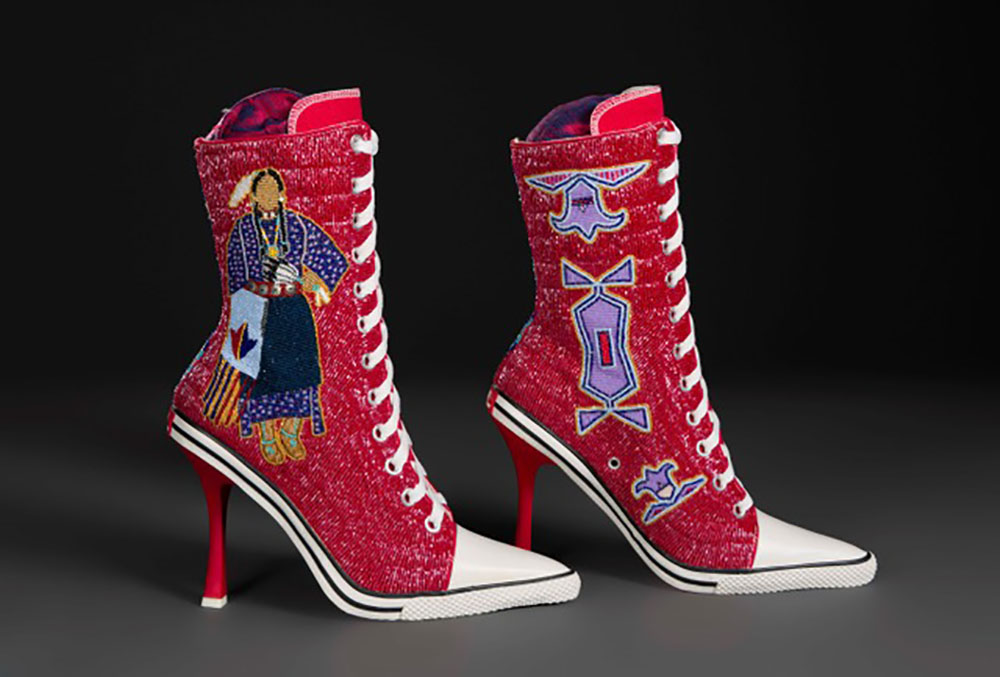
- Details
- By Neely Bardwell
The New Orleans Museum of Art (NOMA) has recently opened a new exhibit “Fashioning America: Grit to Glamour” that features over 100 designers including Indigenous, Black, immigrant, and women designers.
“This sweeping presentation reflects the American spirit of ingenuity and underscores important stories of opportunity and self-innovation,” the NOMA website explains.
The exhibit uses historical garments, including one from the 19th century, in addition to modern garments, to demonstrate the impact of media and celebrity culture. It will be open for viewing through November 26, 2023. These garments on display help amplify the voices of communities often left out of the mainstream or dominant narratives of American fashion history.
Those who decide to visit can expect to see an elegant day dress by Cherokee designer Lloyd “Kiva” New, a pivotal figure in the history of modern Indigenous design; beaded canvas high-heel sneakers by Kiowa designer Terri Greeves; and a peacoat by Pueblo designer Virgil Ortiz.
At the opening of the exhibit, United Houma Nation Principal Chief Lora Ann Chaisson presented a land acknowledgement.
“Indigenous art and fashion are integral to the American story, and Fashioning America provides a platform for the talent of Native American designers to be shared with a greater audience,” said Chaisson. “Thank you to Crystal Bridges Museum of American Art and NOMA for including the Indigenous community in this exciting exhibition.
NOMA was opened in December of 1911 with only nine works of art, making it New Orleans’ oldest fine arts institution. Today, the museum hosts a permanent collection of nearly 50,000 artworks.
“Fashioning America: Grit to Glamour” was previously at Crystal Bridges Museum of American Art in September 2022, as the museum's first exhibition dedicated to fashion.
More Stories Like This
Native American Designers You Should Know, Part 01Cherokee Nation Showcases Growing Film Slate with Fall Premieres of Incentive-Supported Titles
Chickasaw Artists Represent at Southwestern Association for Indian Arts in Santa Fe
Zuni Partners Share Community-Led Delapna:we Project at ATALM 2025 Conference
Celebrating 50 Years: The Rockwell Museum Looks to the Future with "Native Now"
Help us tell the stories that could save Native languages and food traditions
At a critical moment for Indian Country, Native News Online is embarking on our most ambitious reporting project yet: "Cultivating Culture," a three-year investigation into two forces shaping Native community survival—food sovereignty and language revitalization.
The devastating impact of COVID-19 accelerated the loss of Native elders and with them, irreplaceable cultural knowledge. Yet across tribal communities, innovative leaders are fighting back, reclaiming traditional food systems and breathing new life into Native languages. These aren't just cultural preservation efforts—they're powerful pathways to community health, healing, and resilience.
Our dedicated reporting team will spend three years documenting these stories through on-the-ground reporting in 18 tribal communities, producing over 200 in-depth stories, 18 podcast episodes, and multimedia content that amplifies Indigenous voices. We'll show policymakers, funders, and allies how cultural restoration directly impacts physical and mental wellness while celebrating successful models of sovereignty and self-determination.
This isn't corporate media parachuting into Indian Country for a quick story. This is sustained, relationship-based journalism by Native reporters who understand these communities. It's "Warrior Journalism"—fearless reporting that serves the 5.5 million readers who depend on us for news that mainstream media often ignores.
We need your help right now. While we've secured partial funding, we're still $450,000 short of our three-year budget. Our immediate goal is $25,000 this month to keep this critical work moving forward—funding reporter salaries, travel to remote communities, photography, and the deep reporting these stories deserve.
Every dollar directly supports Indigenous journalists telling Indigenous stories. Whether it's $5 or $50, your contribution ensures these vital narratives of resilience, innovation, and hope don't disappear into silence.
 The stakes couldn't be higher. Native languages are being lost at an alarming rate. Food insecurity plagues many tribal communities. But solutions are emerging, and these stories need to be told.
The stakes couldn't be higher. Native languages are being lost at an alarming rate. Food insecurity plagues many tribal communities. But solutions are emerging, and these stories need to be told.
Support independent Native journalism. Fund the stories that matter.
Levi Rickert (Potawatomi), Editor & Publisher

